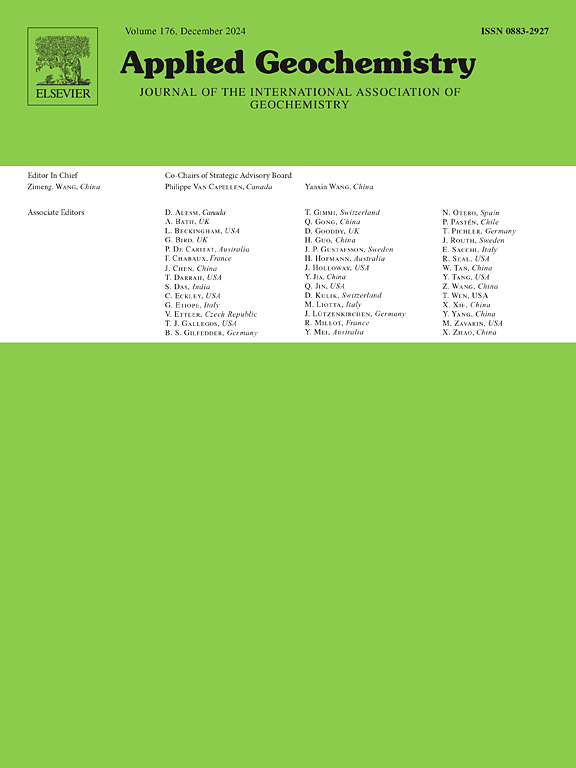Predicting salinity and alkalinity fluxes of U.S. freshwater in a changing climate: Integrating anthropogenic and natural influences using data-driven models
IF 3.1
3区 地球科学
Q1 GEOCHEMISTRY & GEOPHYSICS
引用次数: 0
Abstract
Climate change is an ongoing and intensifying threat. Previous studies indicate that U.S. rivers are undergoing salinization and alkalinization driven by both natural (e.g., temperature and precipitation) and anthropogenic (e.g., population density) factors. In this study, random forest models were developed to predict how the salinity (i.e., sodium) and alkalinity fluxes from 226 U.S. rivers will vary with changing population density and climatic forcings (i.e., temperature and precipitation) from 2040 to 2100 for three socioeconomic development pathways. The models predicted a lower future sodium flux in the northern U.S., likely due to reduced winter road salting under projected warmer winter. In the southern and western U.S., where road salting is uncommon, the models predicted little or no change in future sodium flux, however, a projected warmer and drier climate might exacerbate soil salinization in these regions. The models also indicated that carbonate weathering rates are inhibited when temperatures exceed 10 °C, leading to a lower future alkalinity flux in carbonate-rich watersheds at high temperatures. In siliciclastic-dominated or organic carbon-rich watersheds, rising temperatures are associated with increased riverine alkalinity flux, likely through the acceleration of silicate weathering and decomposition of soil organic carbon. Higher precipitation and enhanced transport capacity were generally deemed to contribute to higher solute fluxes before reaching a plateau. This study underscores the urgency for policymakers and scientists to adapt strategies for managing rivers, focusing on mitigating the impacts of river salinization and shifts in riverine alkalinity driven by global warming.
预测气候变化下美国淡水的盐度和碱度通量:利用数据驱动模型综合人为和自然影响
气候变化是一个持续不断且日益严重的威胁。先前的研究表明,美国河流正在经历自然因素(如温度和降水)和人为因素(如人口密度)的盐碱化和碱化。在这项研究中,开发了随机森林模型来预测从2040年到2100年,美国226条河流的盐度(即钠)和碱度通量将如何随人口密度和气候强迫(即温度和降水)的变化而变化。该模型预测,美国北部未来的钠通量将较低,这可能是由于预计的暖冬减少了冬季道路盐的使用。在美国南部和西部,道路撒盐并不常见,模型预测未来钠通量几乎没有变化,然而,预测的温暖和干燥的气候可能会加剧这些地区的土壤盐碱化。模型还表明,当温度超过10°C时,碳酸盐风化速率受到抑制,导致未来在高温下富含碳酸盐的流域的碱度通量降低。在以硅塑料为主或富含有机碳的流域,温度上升与河流碱度通量增加有关,可能是通过硅酸盐风化和土壤有机碳分解的加速。一般认为,在到达高原之前,较高的降水量和增强的输送能力有助于提高溶质通量。这项研究强调了决策者和科学家调整河流管理战略的紧迫性,重点是减轻全球变暖导致的河流盐碱化和河流碱度变化的影响。
本文章由计算机程序翻译,如有差异,请以英文原文为准。
求助全文
约1分钟内获得全文
求助全文
来源期刊

Applied Geochemistry
地学-地球化学与地球物理
CiteScore
6.10
自引率
8.80%
发文量
272
审稿时长
65 days
期刊介绍:
Applied Geochemistry is an international journal devoted to publication of original research papers, rapid research communications and selected review papers in geochemistry and urban geochemistry which have some practical application to an aspect of human endeavour, such as the preservation of the environment, health, waste disposal and the search for resources. Papers on applications of inorganic, organic and isotope geochemistry and geochemical processes are therefore welcome provided they meet the main criterion. Spatial and temporal monitoring case studies are only of interest to our international readership if they present new ideas of broad application.
Topics covered include: (1) Environmental geochemistry (including natural and anthropogenic aspects, and protection and remediation strategies); (2) Hydrogeochemistry (surface and groundwater); (3) Medical (urban) geochemistry; (4) The search for energy resources (in particular unconventional oil and gas or emerging metal resources); (5) Energy exploitation (in particular geothermal energy and CCS); (6) Upgrading of energy and mineral resources where there is a direct geochemical application; and (7) Waste disposal, including nuclear waste disposal.
 求助内容:
求助内容: 应助结果提醒方式:
应助结果提醒方式:


